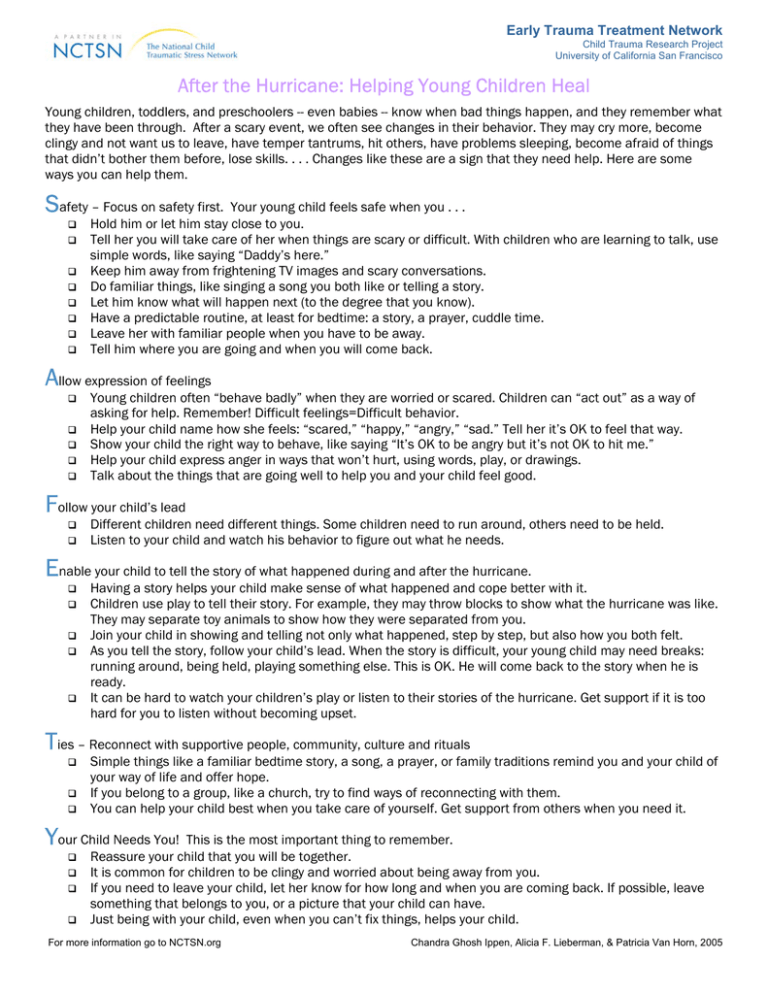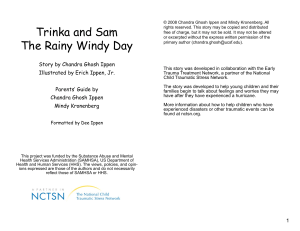After the Hurricane: Helping Young Children Heal
advertisement

Early Trauma Treatment Network Child Trauma Research Project University of California San Francisco After the Hurricane: Helping Young Children Heal Young children, toddlers, and preschoolers -- even babies -- know when bad things happen, and they remember what they have been through. After a scary event, we often see changes in their behavior. They may cry more, become clingy and not want us to leave, have temper tantrums, hit others, have problems sleeping, become afraid of things that didn’t bother them before, lose skills. . . . Changes like these are a sign that they need help. Here are some ways you can help them. Safety – Focus on safety first. Your young child feels safe when you . . . Hold him or let him stay close to you. Tell her you will take care of her when things are scary or difficult. With children who are learning to talk, use simple words, like saying “Daddy’s here.” Keep him away from frightening TV images and scary conversations. Do familiar things, like singing a song you both like or telling a story. Let him know what will happen next (to the degree that you know). Have a predictable routine, at least for bedtime: a story, a prayer, cuddle time. Leave her with familiar people when you have to be away. Tell him where you are going and when you will come back. Allow expression of feelings Young children often “behave badly” when they are worried or scared. Children can “act out” as a way of asking for help. Remember! Difficult feelings=Difficult behavior. Help your child name how she feels: “scared,” “happy,” “angry,” “sad.” Tell her it’s OK to feel that way. Show your child the right way to behave, like saying “It’s OK to be angry but it’s not OK to hit me.” Help your child express anger in ways that won’t hurt, using words, play, or drawings. Talk about the things that are going well to help you and your child feel good. Follow your child’s lead Different children need different things. Some children need to run around, others need to be held. Listen to your child and watch his behavior to figure out what he needs. Enable your child to tell the story of what happened during and after the hurricane. Having a story helps your child make sense of what happened and cope better with it. Children use play to tell their story. For example, they may throw blocks to show what the hurricane was like. They may separate toy animals to show how they were separated from you. Join your child in showing and telling not only what happened, step by step, but also how you both felt. As you tell the story, follow your child’s lead. When the story is difficult, your young child may need breaks: running around, being held, playing something else. This is OK. He will come back to the story when he is ready. It can be hard to watch your children’s play or listen to their stories of the hurricane. Get support if it is too hard for you to listen without becoming upset. Ties – Reconnect with supportive people, community, culture and rituals Simple things like a familiar bedtime story, a song, a prayer, or family traditions remind you and your child of your way of life and offer hope. If you belong to a group, like a church, try to find ways of reconnecting with them. You can help your child best when you take care of yourself. Get support from others when you need it. Your Child Needs You! This is the most important thing to remember. Reassure your child that you will be together. It is common for children to be clingy and worried about being away from you. If you need to leave your child, let her know for how long and when you are coming back. If possible, leave something that belongs to you, or a picture that your child can have. Just being with your child, even when you can’t fix things, helps your child. For more information go to NCTSN.org Chandra Ghosh Ippen, Alicia F. Lieberman, & Patricia Van Horn, 2005






